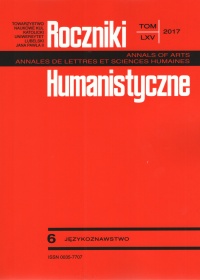Against a movement analysis of dać + się + infinitive structure in Polish
Abstract
The paper analyses the syntax of the dać + się + infinitive structure in Polish. Semantically speaking, the structure comprises generic statements expressing the modal sense of capability. From the syntactic point of view, it shows argument realization typical of the passive and the middle construction, namely the thematic internal argument surfaces in the subject position. Since the dać + się + infinitive structure is superficially similar to passives and middles, an attempt is made to check whether it can be movement-derived, the way it has been commonly postulated for passives and middles. Actually, it is argued that the Polish dać + się + infinitive structure shares a number of syntactic properties with German lassen-middles, which have been recently analysed in terms of movement by Pitteroff (2014). The paper examines whether a movement-based derivation of the Polish dać + się + infinitive structure is tenable. Although initially attractive, after closer scrutiny, Pitteroff’s account turns out to be inapplicable to the Polish structure analysed here. Instead, it is suggested that the surface subject is based-generated within the matrix clause, and does not reach this position by means of movement of any kind.
References
Ackema P., Schoorlemmer M.: Middles, in: The Blackwell companion to syntax, vol. III, eds. M. Everaert and H. van Riemsdijk, Oxford 2005, pp. 131-203.
Alexiadou A.: Non-canonical passives revisited: Parameters of non-active Voice, “Linguistics” 50(2012), pp. 1079-1110.
Alexiadou A., Anagnoustopoulou E., Schäfer F.: The properties of anticausatives cross-linguistically, in: Phases of interpretation, ed. M. Frascarelli, Berlin 2006, pp. 187-211.
Baker M.: Incorporation, Chicago 1988.
Baker M., Johnson K., Roberts I.: Passive arguments revisited, “Linguistic Inquiry” 20(1989), pp. 219-251.
Biały A.: Polish psychological verbs at the lexicon-syntax interface in cross-linguistic perspective, Ph.D. dissertation, Wrocław University 2004.
Bondaruk A.: A comparison of the modal dać się structure with the dispositional middle in Polish, “Linguistics Beyond and Within” 1(2015), pp. 43-63; http://lingbaw.com/volumes/2015/
Bondaruk A.: The modal dać się structure in Polish is syntactically causative, ms., John Paul II Catholic University of Lublin.
Chomsky N.: Lectures on government and binding, Dordrecht 1981.
Chomsky N.: Minimalist inquiries: The framework, in: Step by step, eds. R. Martin, D. Michaels and J. Uriagereka, Cambridge (MA) 2000, pp. 89-155.
Chomsky N.: Derivation by phase, in: Ken Hale. A life in language, ed. M. Kenstowicz, Cambridge (MA) 2001, pp. 1-52.
Chomsky N.: On phases, in: Foundational issues in linguistic theory. Essays in honor of Jean-Roger Vergnaud, eds. R. Freidin, C.P. Otero, M.L. Zubizarreta, Cambridge (MA) 2008, pp. 134-166.
Collins Ch.: A smuggling approach to the passive in English, “Syntax” 8(2005), pp. 81-120.
Embick D.: Localism versus globalism in morphology and phonology, Cambridge (MA) 2010.
Everaert M.: The Syntax of reflexivisation, Dordrecht 1986.
Fagan S.M.B.: The syntax and semantics of middle constructions: A study with special reference to German, Cambridge 1992.
Fanselow G.: Minimale Syntax, Groningen 1991.
Grewendorf G.: Refexivierung in deutschen A.c.i.-Konstruktionen. Kein transformationsgrammatisches Dilemma mehr, “Groninger Arbeiten zur germanistischen Linguistik“ 23(1983), pp.120-196.
Halle M., Marantz A.: Distributed morphology and the pieces of inflection, in: The view from building 20, eds. K. Hale and S. J. Keyser, Cambridge (MA) 1993, pp. 111-176.
Harley H., Noyer R.: State-of-the-article: Distributed Morphology, “Glot International” 4(1999), pp. 3-9.
Hoekstra T., Roberts I.: Middle constructions in Dutch and English, in: Knowledge and language II. Lexical and conceptual structure, eds. E. Reuland and W. Abraham, Dordrecht 1993, pp. 183-220.
Jaeggli O.: Passive, “Linguistic Inquiry” 17(1986), pp. 587-622.
Keyser S., Roeper T.: On the middle and ergative construction in English, “Linguistic Inquiry” 13(1984), pp. 381-416.
Kibort A.: Passive and passive-like constructions in English and Polish, Ph.D. dissertation, University of Cambridge 2004.
Klingvall E.: How to approach complex passives, in: Discourse and Grammar. A festschrift in honor of Valéria Molnar, eds. J. Brandtler, D. Håkansson, S. Huber and E. Klingvall, Lund 2012, pp. 395-410.
Krzek M.: The syntax of impersonal constructions in Polish, Ph.D. dissertation, University of Newcastle 2013.
Kunze J.: Plain middles and ‘lassen’ middles in German: Reflexive constructions and sentence perspective, “Linguistics” 34(1996), pp. 645-695.
Kupść A.: Haplology of the Polish reflexive marker, in: Slavic in Head-Driven Phrase Structure Grammar, eds. R. D. Borsley and A. Przepiórkowski, Stanford (CA) 1999, pp. 91-124.
Lekakou M.: In the middle, somewhat elevated. The semantics of middles and its crosslinguistic realization, Ph. D. dissertation, University of London 2005.
Marantz A.: No escape from syntax: Don’t try morphological analysis in the privacy of your own lexicon, “University of Pennsylvania Working Papers in Linguistics” 4(1997), pp. 201-225.
Marelj M.: Middles and argument structure across languages, Ph.D. dissertation, Utrecht Institute of Linguistics 2004.
Pitteroff M.: Non-canonical lassen-middles, Ph.D. dissertation, University of Stuttgart 2014.
Reis M.: Reflexivierung in deutschen A.c.I.-Konstruktionen. Ein Transformations-grammatisches Dilemma, “Papiere zur Linguistik” 9(1976), pp. 5-82.
Stroik T.: Middles and movement, “Linguistic Inquiry” 23(1992), pp. 127-137.
Topolińska Z.: The verb dać/ dawać in Polish periphrastic constructions, in: Studies in Polish morphology and syntax, eds. G. Henstchel and R. Laskowski, München 1993, pp. 229-249.
Vendler Z.: Linguistics in Philosophy, Ithaca 1967.
Waldenfels R. von: The grammaticalization of ‘give’ + infinitive. A comparative study of Russian, Polish, and Czech, Berlin 2012.
Copyright (c) 2017 Roczniki Humanistyczne

This work is licensed under a Creative Commons Attribution-NonCommercial-NoDerivatives 4.0 International License.





